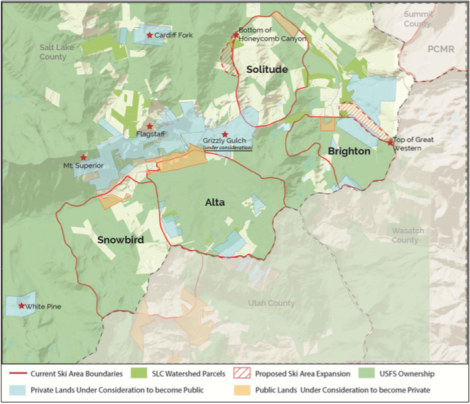For the past seven weeks, Save Our Canyons has been engaged in a negotiation to figure out our future participation in the Mountain Accord process. As I listened to discussions at our Board Retreat in November, I began to realize there was little, if any good, coming out of the Mountain Accord process especially for the environment, our water, but also for the many dispersed recreational interest that connect so many of us to this unique mountain mecca. Despite overwhelming opposition to a train and tunnels in our mountains from system groups (there was not majority support these ideas) and also for pushing ski area expansion and “One Wasatch.” I questioned, why are we still participating and began evaluating our options: I came up with two…
- Leave the process because it was doing more harm than good.
- Strive to make the process do more good (or at least include some good) than harm.
After numerous conversations with the Save Our Canyons board and our partners with whom we represent on the Mountain Accord, I decided to give option #2 a shot, full well knowing that #1 could be an option down the road. The premise for me as I thought is, one of the greatest threats to this landscape, particularly the Central Wasatch, as I’ve found over the years is uncertainty. If we can remove this uncertainty, or significantly reduce it, we have a unique opportunity to remove the threats to the Wasatch. Over the years, the most threatened and volatile areas of the Wasatch reside on the lands owned by the ski resorts – Mount Superior threatened with subdivisions and roller coasters, Flagstaff by ski area expansion under the guise of avalanche control, Grizzly Gulch by One Wasatch, Silver Fork by resort expansion, Guardsman Pass by One Wasatch and the threat of year round vehicle access. Is there a way to put these increasingly creative threats to bed once and for all? The short answer is yes… but for what in exchange.
Before you read any further, the Mountain Accord is a public process and we want your input on how to move forward! Click here to view the Mountain Accord “Booklet” and 2 page summary of the Cottonwood Canyon Task Force negotiations then visit www.mountainaccord.com to submit your concerns, ideas and feelings about the future of the Wasatch.
We engaged with the Mountain Accord, the Cottonwood Ski areas, and elected officials to see if there was a willingness to negotiate the transfer of lands owned by resorts. All agreed to try, so in mid-December convened by a facilitator from the Mountain Accord, representatives from the USFS, Snowbird, Solitude, Brighton, Alta, Town of Alta, Salt Lake City, Salt Lake County, the Outdoor Industry, and Save Our Canyons sat down for our first of four negotiations of what will go down in history of being called the Cottonwood Canyons Task Force.
While brevity is not my strength (context is important), I will attempt to summarize the negotiations, some 20 hrs of meetings over six weeks. First, the entire negotiation was predicated upon a rail and tunnels between Little Cottonwood and Big Cottonwood. This is how it was framed – go big, get big. Resorts want efficient, reliable, convenient and safe transportation and they believe that rail best for this. We disagree, but sweeping conservation gains of resort owned lands were not going to happen if buses were the option. Too, resorts want connectivity. This can happen over the snow and ridges in form of lifts (a la One Wasatch) or through the mountain via tunnel with fixed guideway… though rail has a WOW factor attractive to resorts. We, and by we I mean a host of conservation and recreation organizations and our members, have little if any interest in seeing trains in the canyons, however we also have little interest in seeing more development outside resort boundaries, One Wasatch and the other aforementioned (and yet to be dreamed) schemes to exploit the Wasatch.
 Map resulting from yet to be agreed to negotiations.
Map resulting from yet to be agreed to negotiations.
Resorts also want more development to accommodate the influx of visitation they project they will see with the projected population growth in the region. Today, this development pattern, which some would characterize as “mountain sprawl,” is undesirable. However, with modifications of the ownership patterns we could cluster development to protect key recreation access points, vantage points, connectivity corridors and ultimately our watersheds. Some resort expansion is also requested as part of this. Snowbird further into Mineral Basin and Mary Ellen Gulch, Solitude a bit into Silver Fork, and Brighton into Hidden Canyon. With the exception of Snowbird, Solitude and Brighton’s request are minor boundary adjustments bringing areas already used heavily by resort skiers into the ski area boundary.
The crux of the whole effort has been, their request for a train, 100 or so acres of base development and expansion into Mt. Wolverine/Mt. Tuscarora/Catherine Pass area. This point has yet to be resolved because of significant resistance particularly from Save Our Canyons, and the Outdoor Industry represented by Peter Metcalf. As put by Save Our Canyons co-founder and Wasatch Tours author, Alexis Kelner in Volume 2 of Wasatch Tours describing Tuscarora/Wolverine/Catherine Pass, “This tour was more appealing before ski lifts were thrust into Albion Basin, but the spectacular scenery compensates (somewhat) for the commercial intrusion. The Catherine Pass trail is the most popular route between Alta and Brighton in both summer and winter.” Alexis also noted, looking into his futuristic snow globe, that this area should be noted as “End." (Endangered) a notation used to warn tourers that an area has high potential for being absorbed into a commercial ski area operation. Fair to say that expansion into this area, in our opinion, will jeopardize the whole negotiation.
So, what is the up shot in all this? Over 2,000 acres of land owned by ski resorts including areas like the Pink Pine Ridge, Mt. Superior, Flagstaff, Days Fork, upper Silver Fork, Davenport Hill, Grizzly Gulch, and Guardsman Pass area going into permanent protection (like Wilderness or National Monument) forever removing the threat of development. This of course is in addition to additional protection on other areas as we’ve proposed in the past. Over the years, to use Alexis’ terminology, its been common practice to add “End.” or “R.I.P.” to some of our favorite places in the Wasatch. It has not been very often, however, to remove those notations. This effort allows that opportunity. Time for another edition of Wasatch Tours, Alexis!
No doubt this effort will go down in history – my expectation is that it goes down in history alongside the protection of Yellowstone and Yosemite, not like Echo Park, which sacrificed Glen Canyon to protect Dinosaur’s Echo Park, and the Yampa and Green Rivers. A unique and spectacular landscape for sure, but worth drowning the Glen and choking the Grand Canyon? We’ve worked to shape this outcome, now we need YOU to help us understand whether or not it is a good deal. The train and additional development are certainly undesirable, but the lure of conservation of valued private lands in the Central Wasatch is attractive. Send us your thoughts, make sure the Mountain Accord gets them too. The comment period begins Feb. 4. There will be more info part of this than what we’ve presented here.
Please let us know your thoughts, we tried our best through this process, but the ultimate protection of the Wasatch lies in the opinions of our community and validation of the ideas that we’ve carefully advocated for to better the Wasatch for today, and for tomorrow. Inaction at this point, is not an option – add your voice to the Mountain Accord, and ensure that future generations have clean water, habitat for a community of wildlife, places to enjoy the wilderness, and places to enjoy unprecedented recreational access to an intact and wild landscape – our island of wild in a sea of booming population growth.
This is critical, we need your voice now!
In conservation,
Carl

